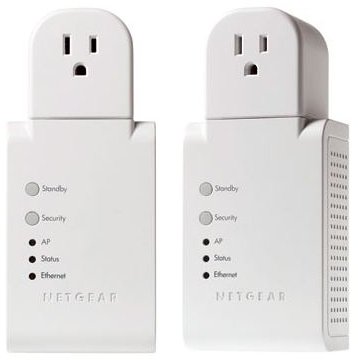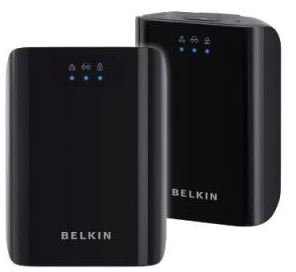What Is Power Line Networking, and Why it Is Awesome
In The Shadows
Since the first cheap, mass-produced wireless routers became available several years ago, wireless has become the most common home networking solution. Because no wires are needed, going with a wireless network allows for extreme flexibility when deciding where to place various networked devices in your home. It also eliminates the long, time-consuming process of finding ways to hide Ethernet wires as they snake from one device to the next.
Wireless networking has its disadvantages, however. The consistency of a wireless network is not as solid as that of a wired network. Although wireless networks are theoretically capable of speeds far faster than anyone could ever need, actually using a wireless network can sometimes be frustrating, particularly when working with a device that exists at the edge of the network’s range. Interference from other radio signals or the structure of your home can make these issues even worse.
But there is a third option. Power-Line Networking, an unsung hero of home networking, has been starting to gain popularity. If offers a compromise between wired and wireless solutions, or can be combined with those forms of networks in order to create a faster and more redundant home network. If you’ve never heard of power-line networking before, then read on; it might be just the thing to solve your networking woes.
How Does It Work?
If you pay close attention to broadband networking technology, then you may have heard on-again-off-again talk about Broadband Over Power-Lines (BPL). The idea behind this technology is simple. Power-lines are capable of transmitting data, and this means they can be used just like cable or telephone lines. In terms of a large, nation-wide roll-out of such technology, this provides a major advantage; the infrastructure already exists. There is no need to bury new lines, because all the wiring you could ever need is already in place.
There are numerous downsides, however, which have handicapped attempts to make BPL a reality. Power-lines are extremely “noisy” compared to other way of transmitting data, which means that fluctuations of power across the power grid could disrupt service. Power-lines also are noisy in the sense that they are unshielded, and will act like antennas broadcasting the data they transmit. This can interfere with radio signals. These are serious problems, and are significant enough that BPL technology will probably never be as popular as more traditional cable, DSL, and fiber-optic networks. However, when the concept is downsized to fit into your home, the advantages begin to fade. Home power lines don’t cause much interference, and while there may still be a fair amount of noise in the connection, the short distance between connections makes this atrivial problem. With those two problems out of the way, we are left with only the one big advantage; the lack of need to run new wires.
Pros And Cons

Ease of use is probably power-line networking’s greatest perk. Because the wiring already exists in your home, all you need to make use of your power lines is two or more adapters. These adapters are simply devices which plug into an existing power outlet and have one or more Ethernet jacks. Overall, installing a power-line networking is even easier than installing a wireless one. You don’t even need to mess with passwords. Simply plug two adapters into power outlets, attach devices to them, and you have yourself a network.
More complex networks can be created by using “switch” rather than “bridge” adapters. Bridge adapters simply create a connection between two devices, while switches allow multiple devices to communicate through the adapters. You can even use power-line adapters from various manufacturers, if for some reason you decide to switch brands half-way through constructing your home network.
In terms of speed, power line networks tend to represent a compromise. Although many modern power-line network adapters claim speeds of up to 200Mbps, true performance tends to be between 25 and 50Mbps. Perhaps more important is the constant connectivity granted by a power line network. You’ll never have to worry about losing the signal or sudden, unexplainable drops in speed.
There is only one distinct disadvantage; power line network adapters must be connected to a wall socket, unless you have bought a special surge protector with a home network plug integrated into it. In most houses, rooms have only two to six plugs available. Power line networking can be difficult to find room for if you already have enough numerous devices connected to your wall socket.
What To Buy
So, by now you may be thinking that this form of networking could solve a lot of your home networking problems. So the next question is obvious - where do I start?
Thankfully, as already explained, this form of networking is fairly simple. To get a start, all you’ll need to do is buy two adapters, which will be plugged into wall sockets in different rooms. If you simply need a bridge - that is, a connection between only two rooms - and speed is not absolutely crucial, then I would take a serious look at the Netgear XE102. The advantage of this adapter is its small size and unobtrusive design, allowing it be fitted to the socket without causing a major obstruction. The price is competitive, as well.
Going up the food chain, you’ll find Belkin’s 200Mbps Adapters. As I said earlier, these will not actually reach the claimed 200Mbps rating - at least, not most of the time. However, these are still some of the faster products available. Better yet, Belkin’s adapters seem to understand that they are expensive, and therefore shouldn’t look tacky when placed in a decently furnished room.
Remember, though, that you don’t have to use adapters from the same company. They all use the same standard, and so any two adapters should work with each other. So, if you want to use the cheaper Netgear adapters now, and then upgrade to the Belkin adapters later, you may still be able to find use for your old hardware.
In fact, flexibility is the greatest asset of power line networking. Use your imagination. There is no reason why this form of networking can’t be combined with both wired and wireless solutions, so make sure you explore all options in order to find the solution that best fits your needs.
References
PC World: Wi-Fi and Power Line Networking
Images are from Belkin and Netgear press materials.
